|
16th August 2020
The colour of the blues: This is the fourth in a series of blogs about the use of the set of photographs of LEO I that will ultimately enable us to rebuild a virtual LEO.
The colour of the blues.
All of our 101 photographs of the calculator room at Cadby Hall, Hammersmith are in black and white. If you are like me, you will often think about the past set in a world of black and white and all the shades of grey in between. For the photographs of LEO, I expected that - the 1950s and black and white photographs, to fit with a post-war, end of rationing world, trying to rebuild.
Some black and white photography is superb if it is used as an artistic technique. Colour, after all, can distract from the shape and form of the subjects within the image. However, for the purposes of rebuilding a virtual LEO calculator room, black and white can distort the world that was the coloured workplace to many people developing the LEO computer.
This first colour problem became apparent with the LEO 'racks'. Each of the 21 racks could hold up to 12 units which had specific functions, such as a half adder. The racks were taller than the people who worked with them and contained hundreds of hot valves connected into a complex set of electronic components and wires.
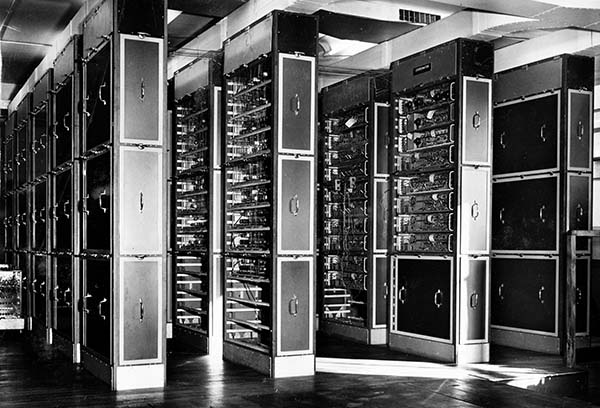
The photograph above shows the LEO racks, some with covering panels and some without. This is photo number 12 in the LEO photoapp that you can see here: http://www.computinghistory.org.uk/leodev/photos/
Each rack was fitted with panels that would hide the electronics inside the rack and present that rectangular, tall and powerful machine image that would emerge in the late 50s. LEO's 21 racks stood like monuments, like silent robots each performing a task unknown to those outside. Almost a Sci-Fi image, these 'thinking machines' and 'brains', words used by many newspaper reports at the time, would provoke curiosity, fear and admiration of the world of automation to come.
With many pictures of the racks, we can see the detail of their construction. We know their height and function, how they were ventilated and who made them. However, something was missing, something in the eye of everyone who worked with LEO, something they all knew and became accustomed to, the colour of LEO.
What colour were the LEO rack panels? They look grey in the photographs, but both documentation and personal accounts informed us that they were in fact 'blue'. Why blue? It isn't a specially important colour for Lyons? And of course, we have the disagreement and wonder about what blue? A bright blue, a royal blue, a powdery blue? It is hard to get a definitive answer, so far!
There are some LEO documents around that might give us clues.
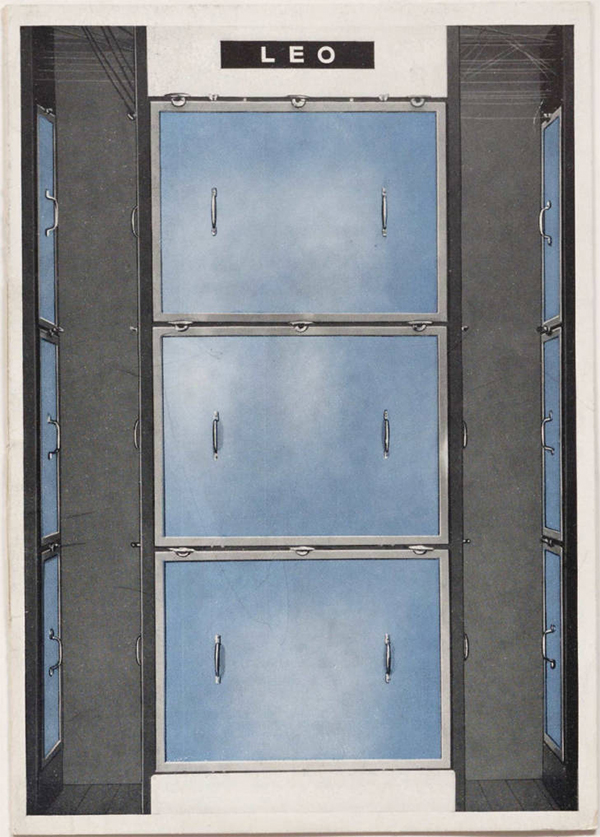
These include a menu of a celebration dinner to mark LEO's success. The paper menu was decorated with a rack (see right) and the rack panels were artificially coloured, but with the right blue? Perhaps.
Marketing material will materialise as LEO II appears and it has touches of blue, but not always the same blue.
People's memories and several artefacts tell us, this is the 'right' blue. But is it?
To recreate the calculator room, we will have to add colour. Some of that will be based on quite specific evidence and for other parts it will be an intelligent guess. What about the parquet flooring, those walls and what about the people?
There has been a great interest in colouring the past. Some have the expertise and time to painstakingly colour a black and white photograph, having researched the subject and making decisions about the colours of specific items. To add to this they have added 'machine intelligence'. Software that will use its 'knowledge' of millions of other photographs to best guess the colour of the items in your black and white photograph.
Of course there are not millions of photographs of other LEO's, so there is a limit to this undoubtedly clever application. Basing a decision on a huge library of images is extremely clever and machine learning is the basis for object recognition and many other applications from recognising a bruised fruit to sorting an initial influx of CVs for a job. It is both powerful and if used appropriately, very useful - at least as a starting point.
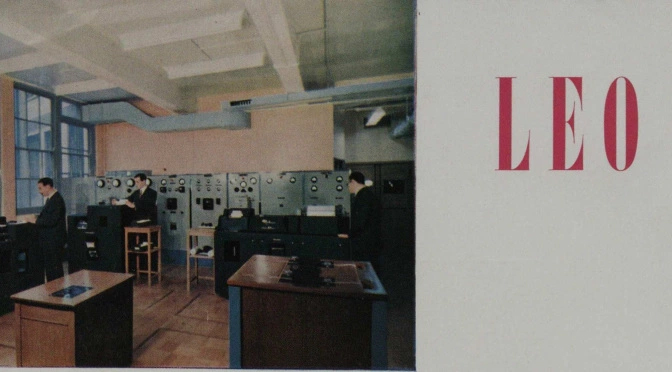
Here is an early attempt to colourise a scene in the calculator room as part of a marketing brochure.
We must be careful though. The colour information in a black and white photograph is lost and cannot be brought to life by some algorithm applied to the black and white pixels. All we can do, by hand or by machine; is to match a known object to other colour photographs and take a best guess.
Skin colour, clothes etc can turn out to be acceptable - mostly, but what of sheets of steel that covered the electronics of LEO?
The work of the 'colourisers' can be seen here:
https://www.youtube.com/watch?v=ecXUU_S6GO4
World War 1 in colour - well an interpretation of colour. I have to confess that despite the reservations, the effect is to offer history through very different eyes and is quite magical and perhaps disturbs our perspective on the past.
What would the machine learning make of some of LEO photographs? I pushed some of the photographs through some free online software, sadly the panels remained grey! But I tried others and below are a few of the results. I have had different responses from 'plausible' to 'creepy', I wonder what you think. Oh and of course if someone out there has an original LEO panel hidden away in their garage then please answer our big mystery, what colour is it?
LEOp19: Pinkerton at the Engineer's panel, a photograph that can be found on the Getty Images website. https://www.gettyimages.co.uk/
It is curious how some of the controls on the panel become bright red!
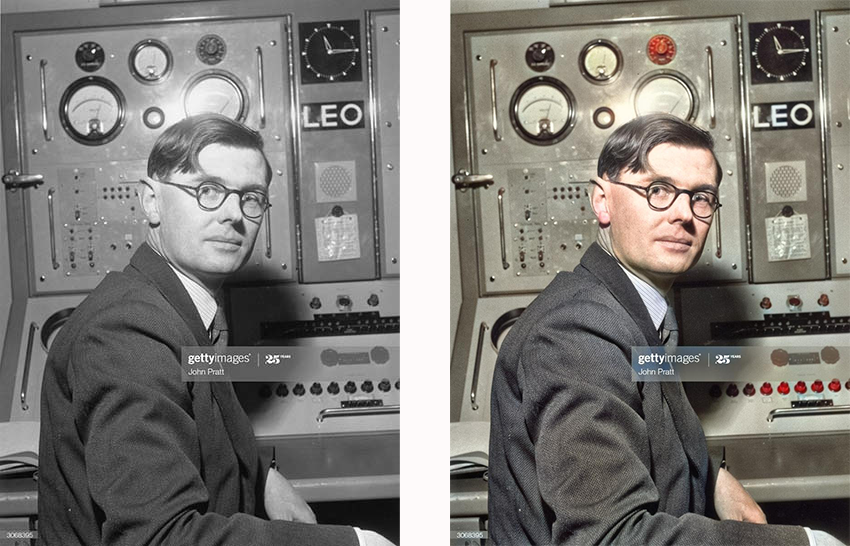
LEOp43: The team in 1950, from the LEO Society Archive.
Those white technicians coats do not look as clean in colour and there is little colour in the LEO electronics behind.

LEOp3: The calculator room, from the LEO Society Archive.
The parquet flooring looks good, but as you can see there is no blue on those LEO panels.
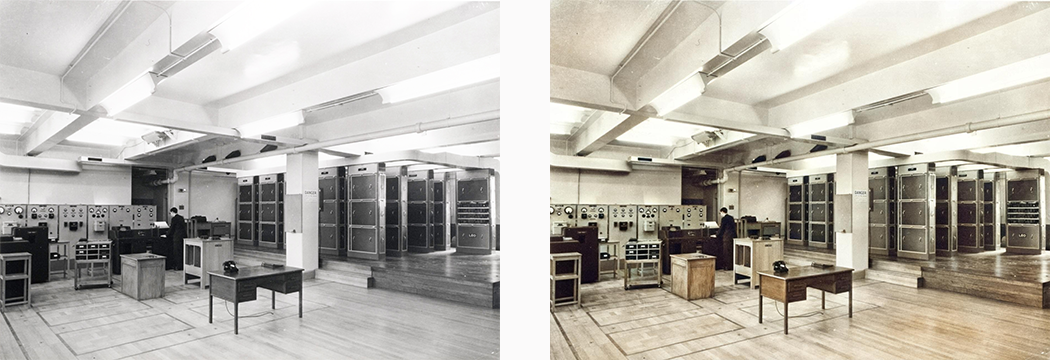
To find out more about colouring photos through machine learning, look here: https://colourise.sg/
Posted by: Chris Monk
|






